Self-Reflection on Dynamic Leadership: MGT601 Report Analysis
VerifiedAdded on 2023/06/04
|9
|2531
|490
Report
AI Summary
This report is a comprehensive self-reflection on dynamic leadership, detailing the author's journey and evolution of their leadership perspectives. It explores personal experiences, particularly in crisis management, and how these experiences have shaped their understanding of leadership as a dynamic and distributed process. The report delves into the author's strengths, identified through Gallup's StrengthsFinder, including restorative abilities, communication skills, discipline, learning aptitude, and a futuristic outlook. The author emphasizes the importance of emotional intelligence, highlighting self-awareness, self-regulation, motivation, empathy, and social skills as key components of effective leadership. The report concludes with reflections on the diverse nature of leadership, the significance of setting a positive example, and the importance of adapting to change and handling resistance within teams. The author also discusses the need to balance empathy with the enforcement of workplace standards. Overall, the report provides a detailed analysis of the author's leadership paradigm and its development through personal and professional experiences.
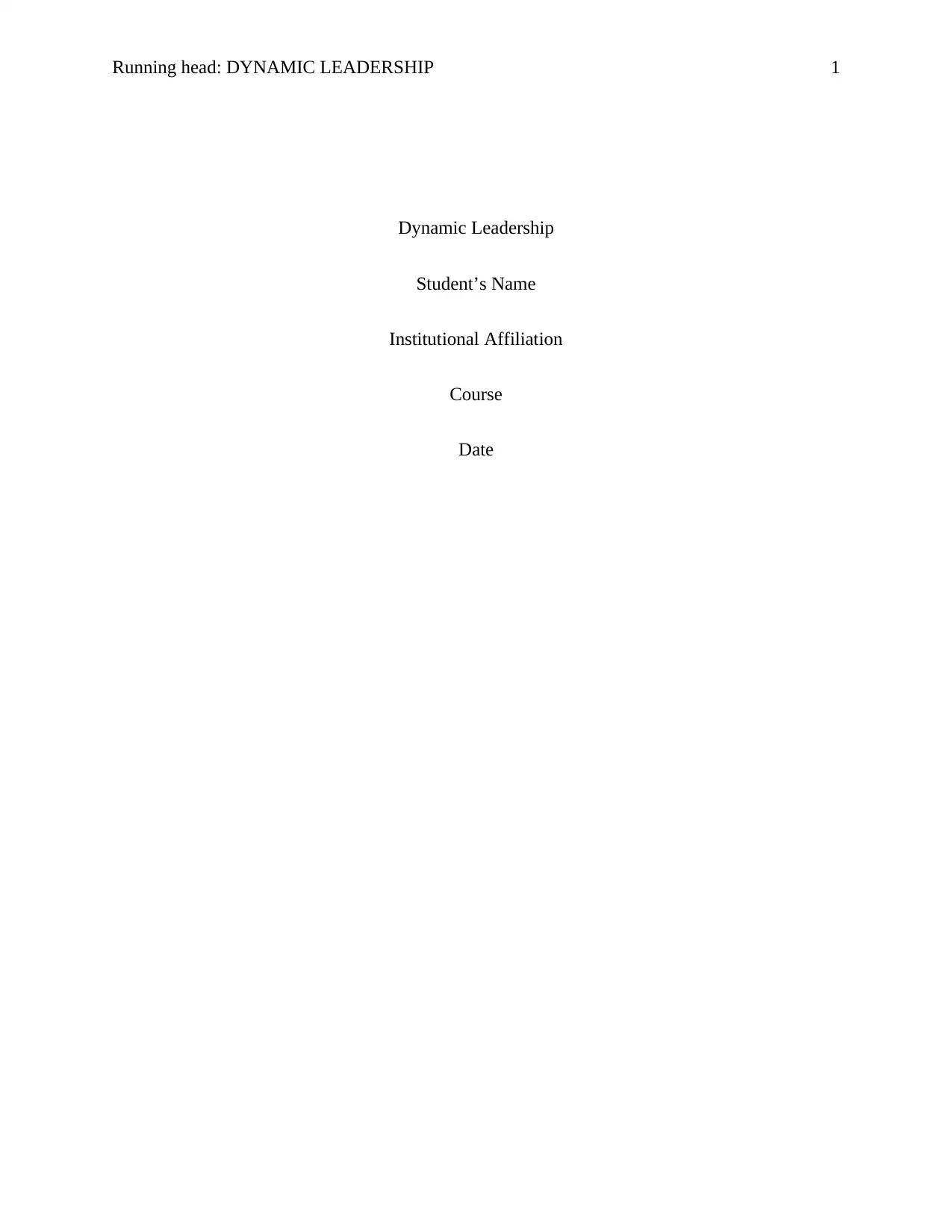
Running head: DYNAMIC LEADERSHIP 1
Dynamic Leadership
Student’s Name
Institutional Affiliation
Course
Date
Dynamic Leadership
Student’s Name
Institutional Affiliation
Course
Date
Paraphrase This Document
Need a fresh take? Get an instant paraphrase of this document with our AI Paraphraser
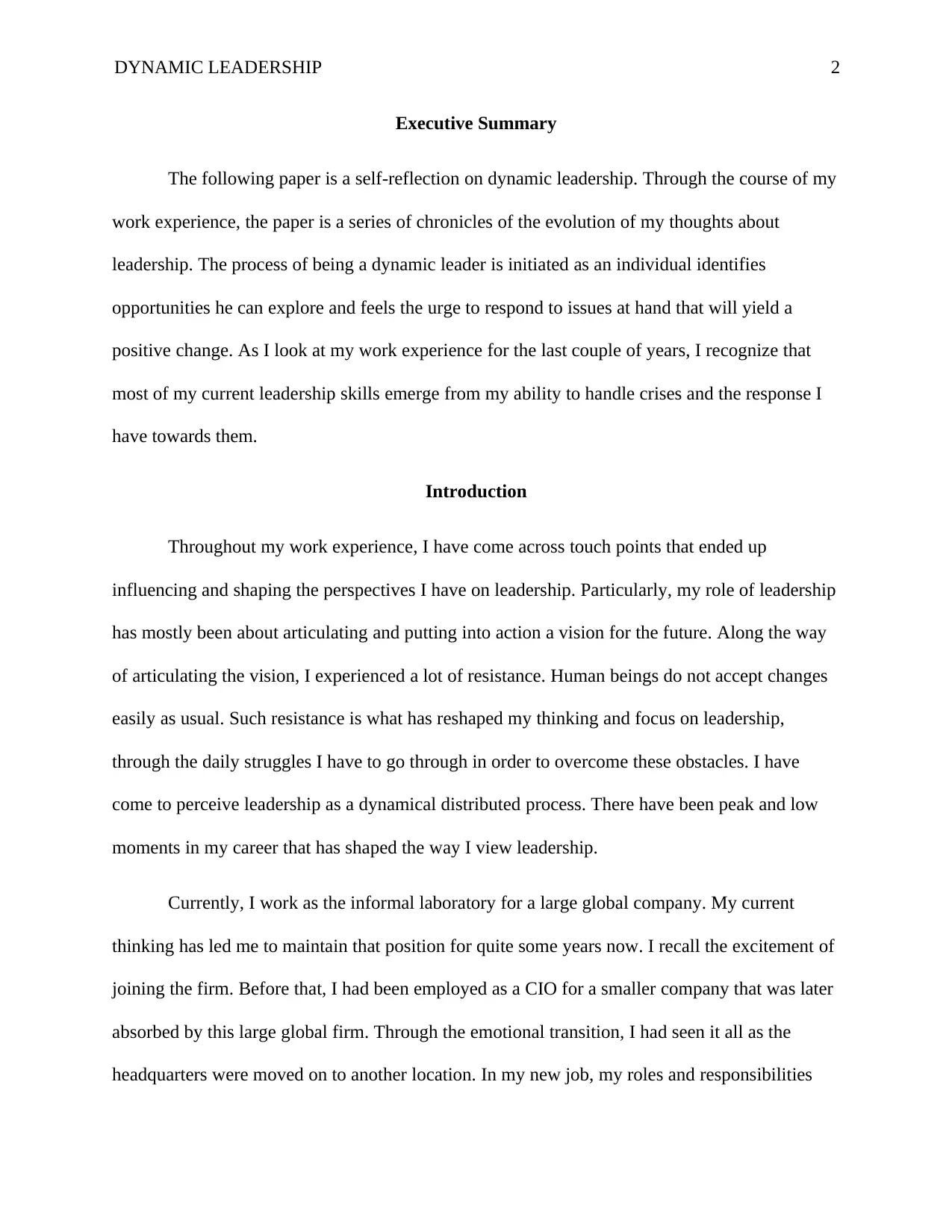
DYNAMIC LEADERSHIP 2
Executive Summary
The following paper is a self-reflection on dynamic leadership. Through the course of my
work experience, the paper is a series of chronicles of the evolution of my thoughts about
leadership. The process of being a dynamic leader is initiated as an individual identifies
opportunities he can explore and feels the urge to respond to issues at hand that will yield a
positive change. As I look at my work experience for the last couple of years, I recognize that
most of my current leadership skills emerge from my ability to handle crises and the response I
have towards them.
Introduction
Throughout my work experience, I have come across touch points that ended up
influencing and shaping the perspectives I have on leadership. Particularly, my role of leadership
has mostly been about articulating and putting into action a vision for the future. Along the way
of articulating the vision, I experienced a lot of resistance. Human beings do not accept changes
easily as usual. Such resistance is what has reshaped my thinking and focus on leadership,
through the daily struggles I have to go through in order to overcome these obstacles. I have
come to perceive leadership as a dynamical distributed process. There have been peak and low
moments in my career that has shaped the way I view leadership.
Currently, I work as the informal laboratory for a large global company. My current
thinking has led me to maintain that position for quite some years now. I recall the excitement of
joining the firm. Before that, I had been employed as a CIO for a smaller company that was later
absorbed by this large global firm. Through the emotional transition, I had seen it all as the
headquarters were moved on to another location. In my new job, my roles and responsibilities
Executive Summary
The following paper is a self-reflection on dynamic leadership. Through the course of my
work experience, the paper is a series of chronicles of the evolution of my thoughts about
leadership. The process of being a dynamic leader is initiated as an individual identifies
opportunities he can explore and feels the urge to respond to issues at hand that will yield a
positive change. As I look at my work experience for the last couple of years, I recognize that
most of my current leadership skills emerge from my ability to handle crises and the response I
have towards them.
Introduction
Throughout my work experience, I have come across touch points that ended up
influencing and shaping the perspectives I have on leadership. Particularly, my role of leadership
has mostly been about articulating and putting into action a vision for the future. Along the way
of articulating the vision, I experienced a lot of resistance. Human beings do not accept changes
easily as usual. Such resistance is what has reshaped my thinking and focus on leadership,
through the daily struggles I have to go through in order to overcome these obstacles. I have
come to perceive leadership as a dynamical distributed process. There have been peak and low
moments in my career that has shaped the way I view leadership.
Currently, I work as the informal laboratory for a large global company. My current
thinking has led me to maintain that position for quite some years now. I recall the excitement of
joining the firm. Before that, I had been employed as a CIO for a smaller company that was later
absorbed by this large global firm. Through the emotional transition, I had seen it all as the
headquarters were moved on to another location. In my new job, my roles and responsibilities
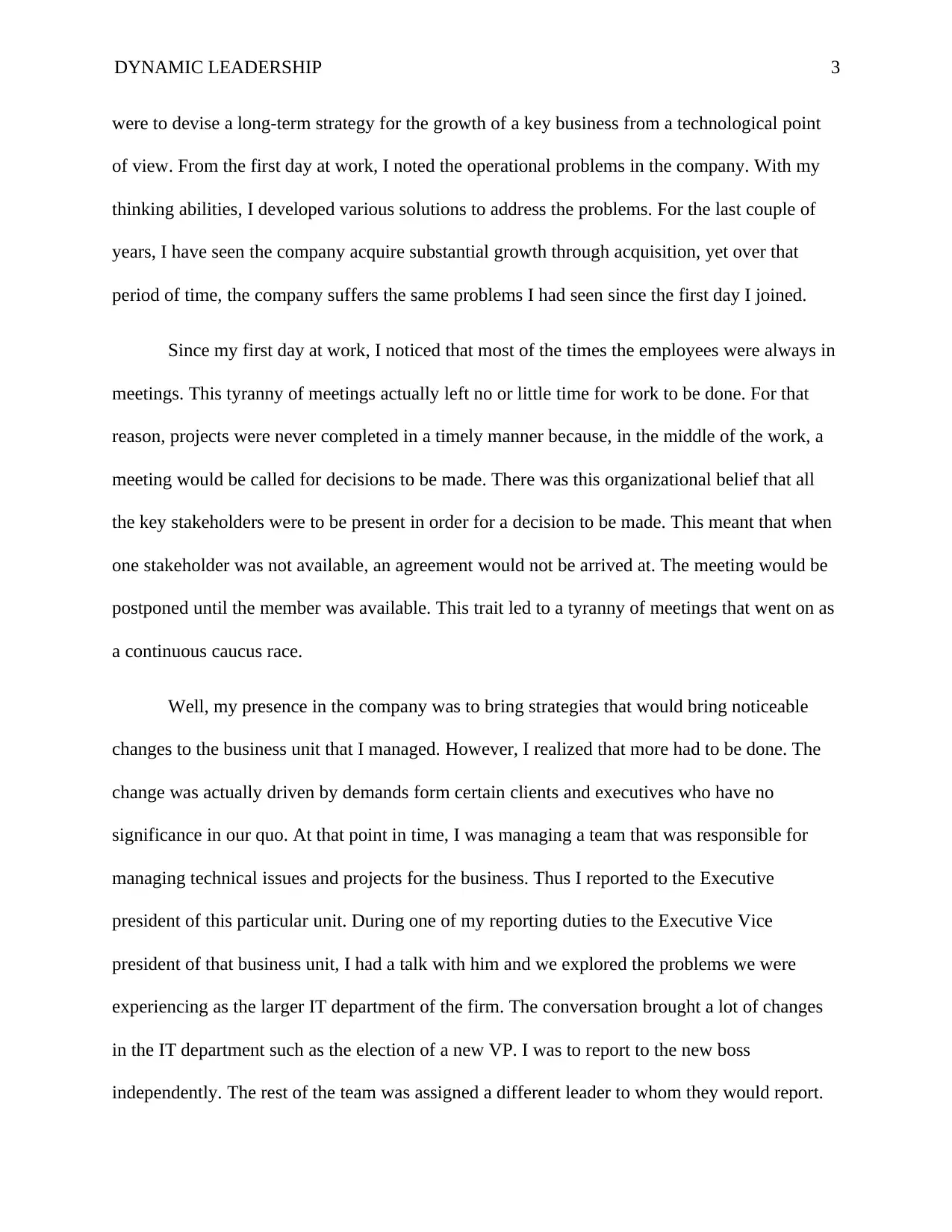
DYNAMIC LEADERSHIP 3
were to devise a long-term strategy for the growth of a key business from a technological point
of view. From the first day at work, I noted the operational problems in the company. With my
thinking abilities, I developed various solutions to address the problems. For the last couple of
years, I have seen the company acquire substantial growth through acquisition, yet over that
period of time, the company suffers the same problems I had seen since the first day I joined.
Since my first day at work, I noticed that most of the times the employees were always in
meetings. This tyranny of meetings actually left no or little time for work to be done. For that
reason, projects were never completed in a timely manner because, in the middle of the work, a
meeting would be called for decisions to be made. There was this organizational belief that all
the key stakeholders were to be present in order for a decision to be made. This meant that when
one stakeholder was not available, an agreement would not be arrived at. The meeting would be
postponed until the member was available. This trait led to a tyranny of meetings that went on as
a continuous caucus race.
Well, my presence in the company was to bring strategies that would bring noticeable
changes to the business unit that I managed. However, I realized that more had to be done. The
change was actually driven by demands form certain clients and executives who have no
significance in our quo. At that point in time, I was managing a team that was responsible for
managing technical issues and projects for the business. Thus I reported to the Executive
president of this particular unit. During one of my reporting duties to the Executive Vice
president of that business unit, I had a talk with him and we explored the problems we were
experiencing as the larger IT department of the firm. The conversation brought a lot of changes
in the IT department such as the election of a new VP. I was to report to the new boss
independently. The rest of the team was assigned a different leader to whom they would report.
were to devise a long-term strategy for the growth of a key business from a technological point
of view. From the first day at work, I noted the operational problems in the company. With my
thinking abilities, I developed various solutions to address the problems. For the last couple of
years, I have seen the company acquire substantial growth through acquisition, yet over that
period of time, the company suffers the same problems I had seen since the first day I joined.
Since my first day at work, I noticed that most of the times the employees were always in
meetings. This tyranny of meetings actually left no or little time for work to be done. For that
reason, projects were never completed in a timely manner because, in the middle of the work, a
meeting would be called for decisions to be made. There was this organizational belief that all
the key stakeholders were to be present in order for a decision to be made. This meant that when
one stakeholder was not available, an agreement would not be arrived at. The meeting would be
postponed until the member was available. This trait led to a tyranny of meetings that went on as
a continuous caucus race.
Well, my presence in the company was to bring strategies that would bring noticeable
changes to the business unit that I managed. However, I realized that more had to be done. The
change was actually driven by demands form certain clients and executives who have no
significance in our quo. At that point in time, I was managing a team that was responsible for
managing technical issues and projects for the business. Thus I reported to the Executive
president of this particular unit. During one of my reporting duties to the Executive Vice
president of that business unit, I had a talk with him and we explored the problems we were
experiencing as the larger IT department of the firm. The conversation brought a lot of changes
in the IT department such as the election of a new VP. I was to report to the new boss
independently. The rest of the team was assigned a different leader to whom they would report.
⊘ This is a preview!⊘
Do you want full access?
Subscribe today to unlock all pages.

Trusted by 1+ million students worldwide
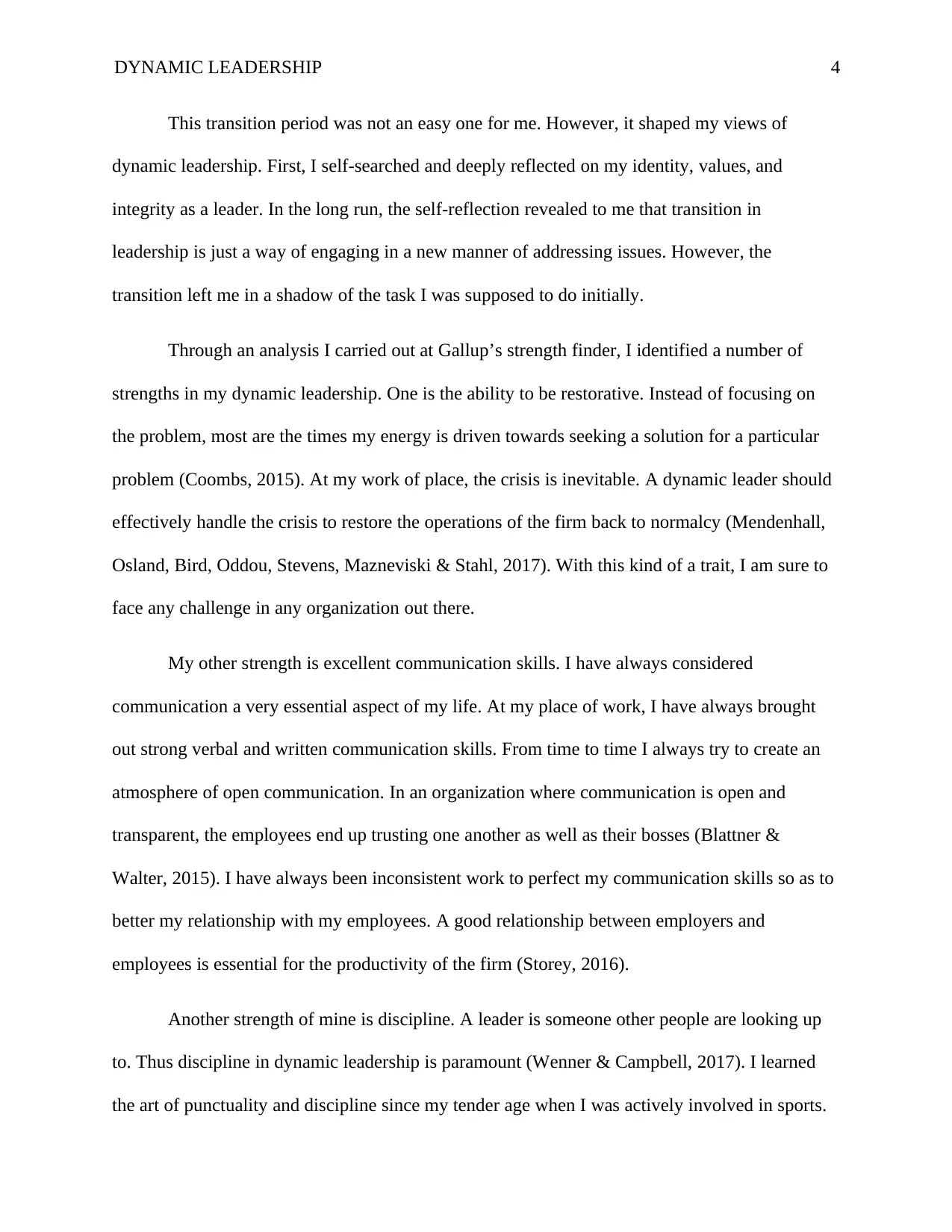
DYNAMIC LEADERSHIP 4
This transition period was not an easy one for me. However, it shaped my views of
dynamic leadership. First, I self-searched and deeply reflected on my identity, values, and
integrity as a leader. In the long run, the self-reflection revealed to me that transition in
leadership is just a way of engaging in a new manner of addressing issues. However, the
transition left me in a shadow of the task I was supposed to do initially.
Through an analysis I carried out at Gallup’s strength finder, I identified a number of
strengths in my dynamic leadership. One is the ability to be restorative. Instead of focusing on
the problem, most are the times my energy is driven towards seeking a solution for a particular
problem (Coombs, 2015). At my work of place, the crisis is inevitable. A dynamic leader should
effectively handle the crisis to restore the operations of the firm back to normalcy (Mendenhall,
Osland, Bird, Oddou, Stevens, Mazneviski & Stahl, 2017). With this kind of a trait, I am sure to
face any challenge in any organization out there.
My other strength is excellent communication skills. I have always considered
communication a very essential aspect of my life. At my place of work, I have always brought
out strong verbal and written communication skills. From time to time I always try to create an
atmosphere of open communication. In an organization where communication is open and
transparent, the employees end up trusting one another as well as their bosses (Blattner &
Walter, 2015). I have always been inconsistent work to perfect my communication skills so as to
better my relationship with my employees. A good relationship between employers and
employees is essential for the productivity of the firm (Storey, 2016).
Another strength of mine is discipline. A leader is someone other people are looking up
to. Thus discipline in dynamic leadership is paramount (Wenner & Campbell, 2017). I learned
the art of punctuality and discipline since my tender age when I was actively involved in sports.
This transition period was not an easy one for me. However, it shaped my views of
dynamic leadership. First, I self-searched and deeply reflected on my identity, values, and
integrity as a leader. In the long run, the self-reflection revealed to me that transition in
leadership is just a way of engaging in a new manner of addressing issues. However, the
transition left me in a shadow of the task I was supposed to do initially.
Through an analysis I carried out at Gallup’s strength finder, I identified a number of
strengths in my dynamic leadership. One is the ability to be restorative. Instead of focusing on
the problem, most are the times my energy is driven towards seeking a solution for a particular
problem (Coombs, 2015). At my work of place, the crisis is inevitable. A dynamic leader should
effectively handle the crisis to restore the operations of the firm back to normalcy (Mendenhall,
Osland, Bird, Oddou, Stevens, Mazneviski & Stahl, 2017). With this kind of a trait, I am sure to
face any challenge in any organization out there.
My other strength is excellent communication skills. I have always considered
communication a very essential aspect of my life. At my place of work, I have always brought
out strong verbal and written communication skills. From time to time I always try to create an
atmosphere of open communication. In an organization where communication is open and
transparent, the employees end up trusting one another as well as their bosses (Blattner &
Walter, 2015). I have always been inconsistent work to perfect my communication skills so as to
better my relationship with my employees. A good relationship between employers and
employees is essential for the productivity of the firm (Storey, 2016).
Another strength of mine is discipline. A leader is someone other people are looking up
to. Thus discipline in dynamic leadership is paramount (Wenner & Campbell, 2017). I learned
the art of punctuality and discipline since my tender age when I was actively involved in sports.
Paraphrase This Document
Need a fresh take? Get an instant paraphrase of this document with our AI Paraphraser
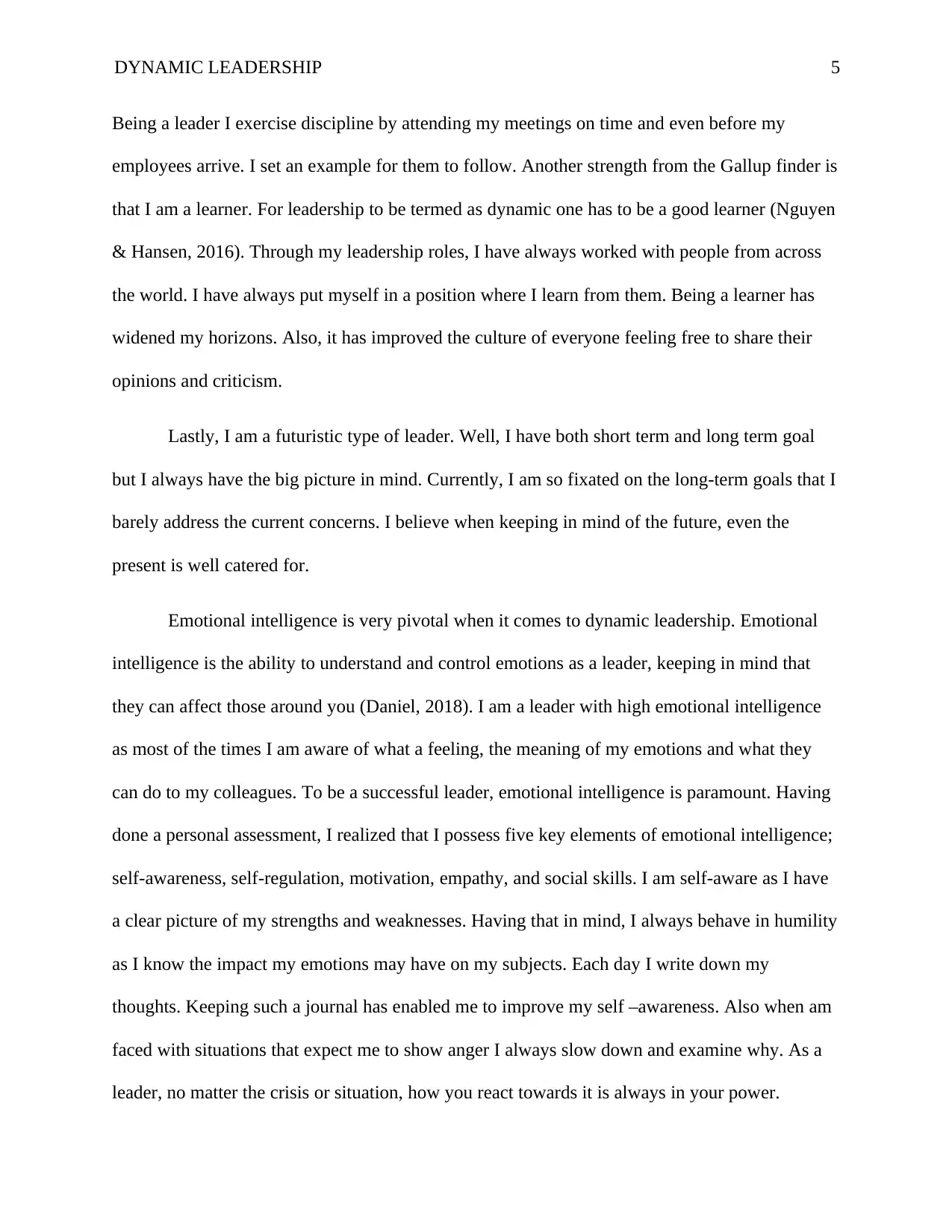
DYNAMIC LEADERSHIP 5
Being a leader I exercise discipline by attending my meetings on time and even before my
employees arrive. I set an example for them to follow. Another strength from the Gallup finder is
that I am a learner. For leadership to be termed as dynamic one has to be a good learner (Nguyen
& Hansen, 2016). Through my leadership roles, I have always worked with people from across
the world. I have always put myself in a position where I learn from them. Being a learner has
widened my horizons. Also, it has improved the culture of everyone feeling free to share their
opinions and criticism.
Lastly, I am a futuristic type of leader. Well, I have both short term and long term goal
but I always have the big picture in mind. Currently, I am so fixated on the long-term goals that I
barely address the current concerns. I believe when keeping in mind of the future, even the
present is well catered for.
Emotional intelligence is very pivotal when it comes to dynamic leadership. Emotional
intelligence is the ability to understand and control emotions as a leader, keeping in mind that
they can affect those around you (Daniel, 2018). I am a leader with high emotional intelligence
as most of the times I am aware of what a feeling, the meaning of my emotions and what they
can do to my colleagues. To be a successful leader, emotional intelligence is paramount. Having
done a personal assessment, I realized that I possess five key elements of emotional intelligence;
self-awareness, self-regulation, motivation, empathy, and social skills. I am self-aware as I have
a clear picture of my strengths and weaknesses. Having that in mind, I always behave in humility
as I know the impact my emotions may have on my subjects. Each day I write down my
thoughts. Keeping such a journal has enabled me to improve my self –awareness. Also when am
faced with situations that expect me to show anger I always slow down and examine why. As a
leader, no matter the crisis or situation, how you react towards it is always in your power.
Being a leader I exercise discipline by attending my meetings on time and even before my
employees arrive. I set an example for them to follow. Another strength from the Gallup finder is
that I am a learner. For leadership to be termed as dynamic one has to be a good learner (Nguyen
& Hansen, 2016). Through my leadership roles, I have always worked with people from across
the world. I have always put myself in a position where I learn from them. Being a learner has
widened my horizons. Also, it has improved the culture of everyone feeling free to share their
opinions and criticism.
Lastly, I am a futuristic type of leader. Well, I have both short term and long term goal
but I always have the big picture in mind. Currently, I am so fixated on the long-term goals that I
barely address the current concerns. I believe when keeping in mind of the future, even the
present is well catered for.
Emotional intelligence is very pivotal when it comes to dynamic leadership. Emotional
intelligence is the ability to understand and control emotions as a leader, keeping in mind that
they can affect those around you (Daniel, 2018). I am a leader with high emotional intelligence
as most of the times I am aware of what a feeling, the meaning of my emotions and what they
can do to my colleagues. To be a successful leader, emotional intelligence is paramount. Having
done a personal assessment, I realized that I possess five key elements of emotional intelligence;
self-awareness, self-regulation, motivation, empathy, and social skills. I am self-aware as I have
a clear picture of my strengths and weaknesses. Having that in mind, I always behave in humility
as I know the impact my emotions may have on my subjects. Each day I write down my
thoughts. Keeping such a journal has enabled me to improve my self –awareness. Also when am
faced with situations that expect me to show anger I always slow down and examine why. As a
leader, no matter the crisis or situation, how you react towards it is always in your power.
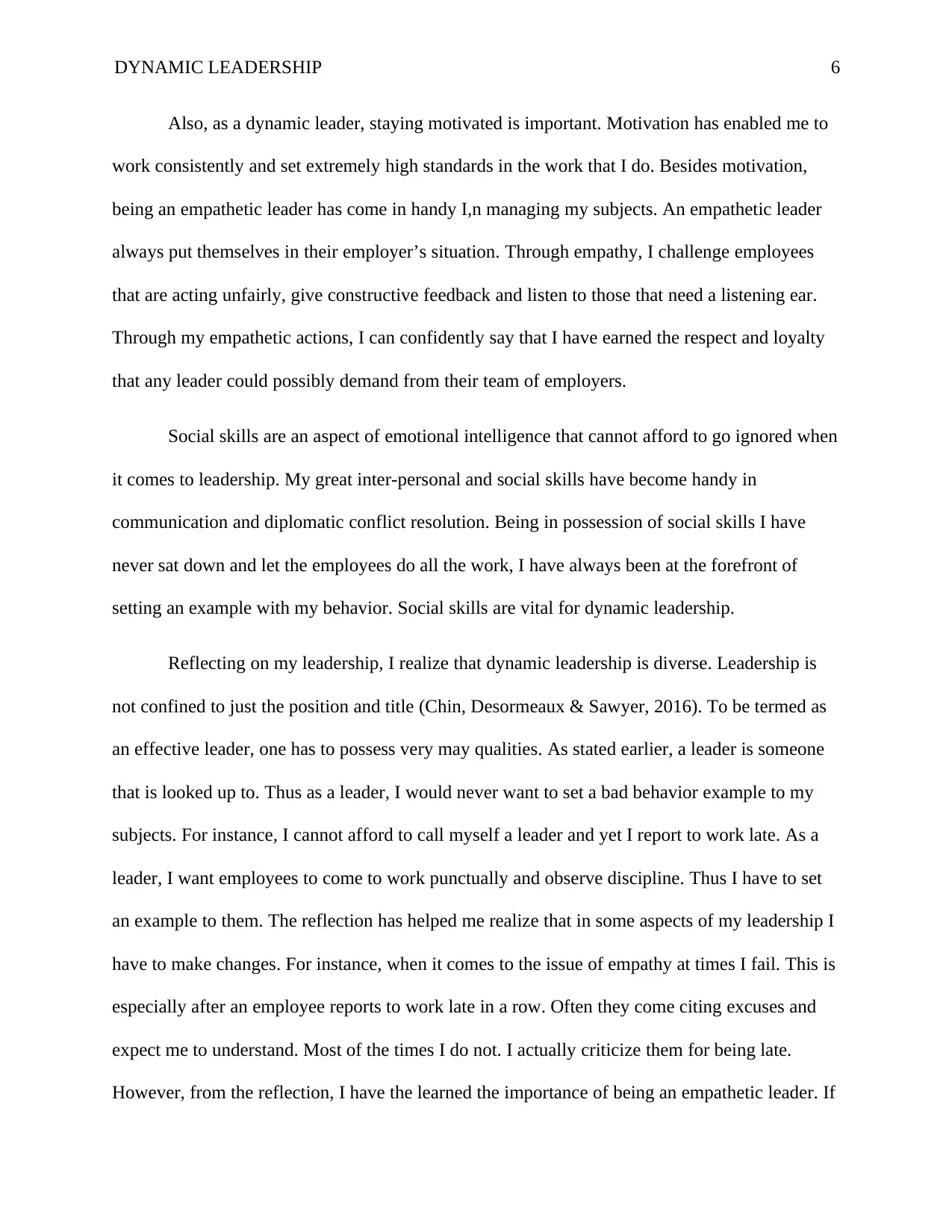
DYNAMIC LEADERSHIP 6
Also, as a dynamic leader, staying motivated is important. Motivation has enabled me to
work consistently and set extremely high standards in the work that I do. Besides motivation,
being an empathetic leader has come in handy I,n managing my subjects. An empathetic leader
always put themselves in their employer’s situation. Through empathy, I challenge employees
that are acting unfairly, give constructive feedback and listen to those that need a listening ear.
Through my empathetic actions, I can confidently say that I have earned the respect and loyalty
that any leader could possibly demand from their team of employers.
Social skills are an aspect of emotional intelligence that cannot afford to go ignored when
it comes to leadership. My great inter-personal and social skills have become handy in
communication and diplomatic conflict resolution. Being in possession of social skills I have
never sat down and let the employees do all the work, I have always been at the forefront of
setting an example with my behavior. Social skills are vital for dynamic leadership.
Reflecting on my leadership, I realize that dynamic leadership is diverse. Leadership is
not confined to just the position and title (Chin, Desormeaux & Sawyer, 2016). To be termed as
an effective leader, one has to possess very may qualities. As stated earlier, a leader is someone
that is looked up to. Thus as a leader, I would never want to set a bad behavior example to my
subjects. For instance, I cannot afford to call myself a leader and yet I report to work late. As a
leader, I want employees to come to work punctually and observe discipline. Thus I have to set
an example to them. The reflection has helped me realize that in some aspects of my leadership I
have to make changes. For instance, when it comes to the issue of empathy at times I fail. This is
especially after an employee reports to work late in a row. Often they come citing excuses and
expect me to understand. Most of the times I do not. I actually criticize them for being late.
However, from the reflection, I have the learned the importance of being an empathetic leader. If
Also, as a dynamic leader, staying motivated is important. Motivation has enabled me to
work consistently and set extremely high standards in the work that I do. Besides motivation,
being an empathetic leader has come in handy I,n managing my subjects. An empathetic leader
always put themselves in their employer’s situation. Through empathy, I challenge employees
that are acting unfairly, give constructive feedback and listen to those that need a listening ear.
Through my empathetic actions, I can confidently say that I have earned the respect and loyalty
that any leader could possibly demand from their team of employers.
Social skills are an aspect of emotional intelligence that cannot afford to go ignored when
it comes to leadership. My great inter-personal and social skills have become handy in
communication and diplomatic conflict resolution. Being in possession of social skills I have
never sat down and let the employees do all the work, I have always been at the forefront of
setting an example with my behavior. Social skills are vital for dynamic leadership.
Reflecting on my leadership, I realize that dynamic leadership is diverse. Leadership is
not confined to just the position and title (Chin, Desormeaux & Sawyer, 2016). To be termed as
an effective leader, one has to possess very may qualities. As stated earlier, a leader is someone
that is looked up to. Thus as a leader, I would never want to set a bad behavior example to my
subjects. For instance, I cannot afford to call myself a leader and yet I report to work late. As a
leader, I want employees to come to work punctually and observe discipline. Thus I have to set
an example to them. The reflection has helped me realize that in some aspects of my leadership I
have to make changes. For instance, when it comes to the issue of empathy at times I fail. This is
especially after an employee reports to work late in a row. Often they come citing excuses and
expect me to understand. Most of the times I do not. I actually criticize them for being late.
However, from the reflection, I have the learned the importance of being an empathetic leader. If
⊘ This is a preview!⊘
Do you want full access?
Subscribe today to unlock all pages.

Trusted by 1+ million students worldwide
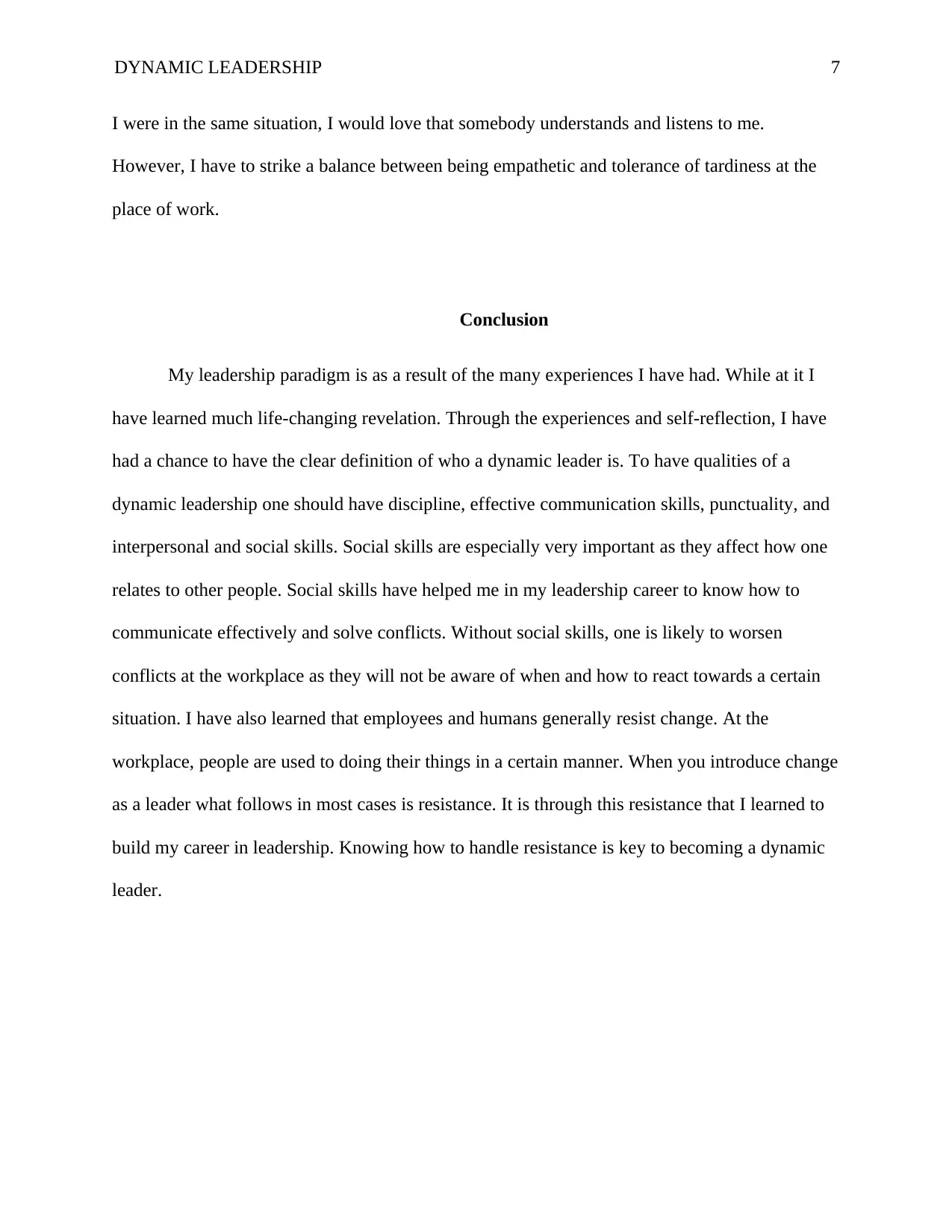
DYNAMIC LEADERSHIP 7
I were in the same situation, I would love that somebody understands and listens to me.
However, I have to strike a balance between being empathetic and tolerance of tardiness at the
place of work.
Conclusion
My leadership paradigm is as a result of the many experiences I have had. While at it I
have learned much life-changing revelation. Through the experiences and self-reflection, I have
had a chance to have the clear definition of who a dynamic leader is. To have qualities of a
dynamic leadership one should have discipline, effective communication skills, punctuality, and
interpersonal and social skills. Social skills are especially very important as they affect how one
relates to other people. Social skills have helped me in my leadership career to know how to
communicate effectively and solve conflicts. Without social skills, one is likely to worsen
conflicts at the workplace as they will not be aware of when and how to react towards a certain
situation. I have also learned that employees and humans generally resist change. At the
workplace, people are used to doing their things in a certain manner. When you introduce change
as a leader what follows in most cases is resistance. It is through this resistance that I learned to
build my career in leadership. Knowing how to handle resistance is key to becoming a dynamic
leader.
I were in the same situation, I would love that somebody understands and listens to me.
However, I have to strike a balance between being empathetic and tolerance of tardiness at the
place of work.
Conclusion
My leadership paradigm is as a result of the many experiences I have had. While at it I
have learned much life-changing revelation. Through the experiences and self-reflection, I have
had a chance to have the clear definition of who a dynamic leader is. To have qualities of a
dynamic leadership one should have discipline, effective communication skills, punctuality, and
interpersonal and social skills. Social skills are especially very important as they affect how one
relates to other people. Social skills have helped me in my leadership career to know how to
communicate effectively and solve conflicts. Without social skills, one is likely to worsen
conflicts at the workplace as they will not be aware of when and how to react towards a certain
situation. I have also learned that employees and humans generally resist change. At the
workplace, people are used to doing their things in a certain manner. When you introduce change
as a leader what follows in most cases is resistance. It is through this resistance that I learned to
build my career in leadership. Knowing how to handle resistance is key to becoming a dynamic
leader.
Paraphrase This Document
Need a fresh take? Get an instant paraphrase of this document with our AI Paraphraser
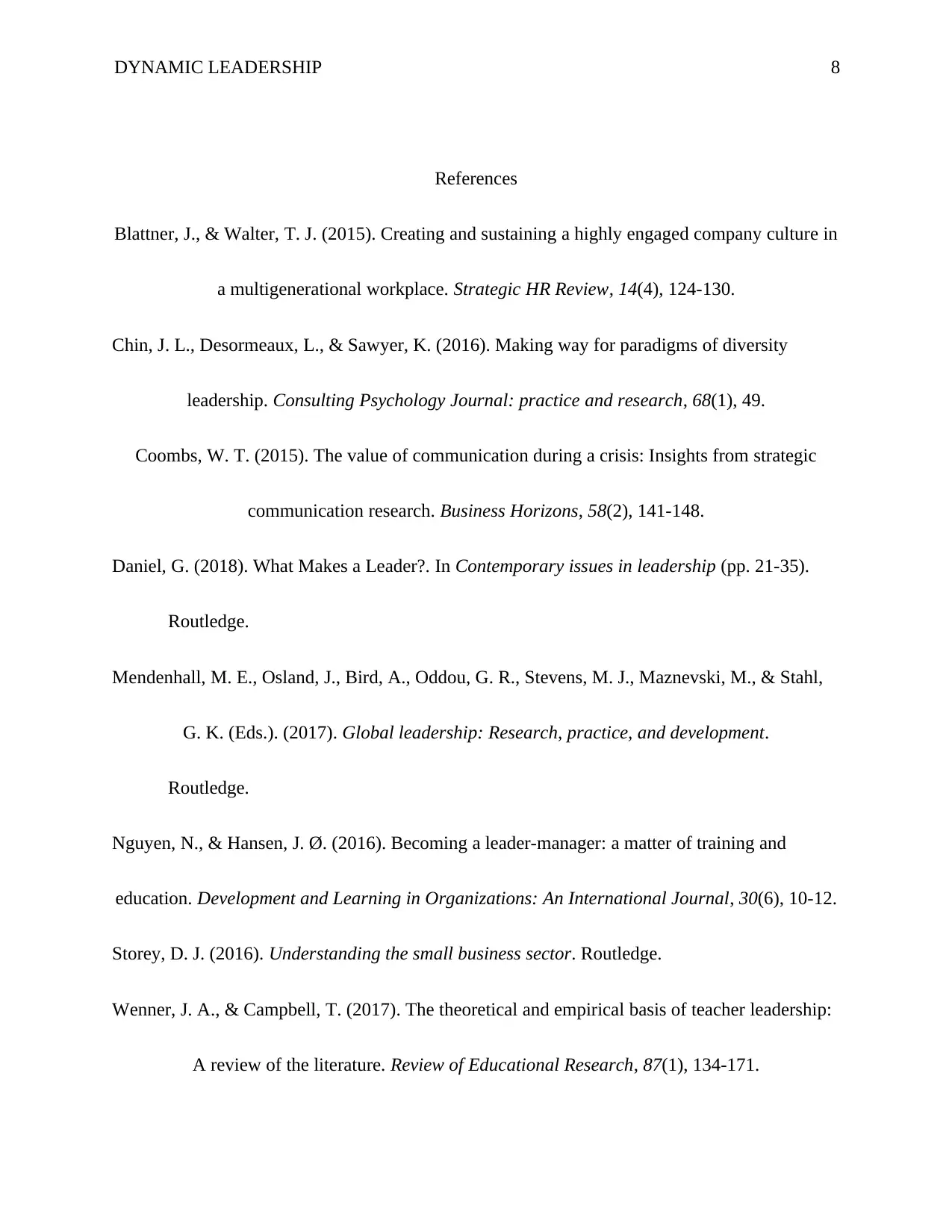
DYNAMIC LEADERSHIP 8
References
Blattner, J., & Walter, T. J. (2015). Creating and sustaining a highly engaged company culture in
a multigenerational workplace. Strategic HR Review, 14(4), 124-130.
Chin, J. L., Desormeaux, L., & Sawyer, K. (2016). Making way for paradigms of diversity
leadership. Consulting Psychology Journal: practice and research, 68(1), 49.
Coombs, W. T. (2015). The value of communication during a crisis: Insights from strategic
communication research. Business Horizons, 58(2), 141-148.
Daniel, G. (2018). What Makes a Leader?. In Contemporary issues in leadership (pp. 21-35).
Routledge.
Mendenhall, M. E., Osland, J., Bird, A., Oddou, G. R., Stevens, M. J., Maznevski, M., & Stahl,
G. K. (Eds.). (2017). Global leadership: Research, practice, and development.
Routledge.
Nguyen, N., & Hansen, J. Ø. (2016). Becoming a leader-manager: a matter of training and
education. Development and Learning in Organizations: An International Journal, 30(6), 10-12.
Storey, D. J. (2016). Understanding the small business sector. Routledge.
Wenner, J. A., & Campbell, T. (2017). The theoretical and empirical basis of teacher leadership:
A review of the literature. Review of Educational Research, 87(1), 134-171.
References
Blattner, J., & Walter, T. J. (2015). Creating and sustaining a highly engaged company culture in
a multigenerational workplace. Strategic HR Review, 14(4), 124-130.
Chin, J. L., Desormeaux, L., & Sawyer, K. (2016). Making way for paradigms of diversity
leadership. Consulting Psychology Journal: practice and research, 68(1), 49.
Coombs, W. T. (2015). The value of communication during a crisis: Insights from strategic
communication research. Business Horizons, 58(2), 141-148.
Daniel, G. (2018). What Makes a Leader?. In Contemporary issues in leadership (pp. 21-35).
Routledge.
Mendenhall, M. E., Osland, J., Bird, A., Oddou, G. R., Stevens, M. J., Maznevski, M., & Stahl,
G. K. (Eds.). (2017). Global leadership: Research, practice, and development.
Routledge.
Nguyen, N., & Hansen, J. Ø. (2016). Becoming a leader-manager: a matter of training and
education. Development and Learning in Organizations: An International Journal, 30(6), 10-12.
Storey, D. J. (2016). Understanding the small business sector. Routledge.
Wenner, J. A., & Campbell, T. (2017). The theoretical and empirical basis of teacher leadership:
A review of the literature. Review of Educational Research, 87(1), 134-171.
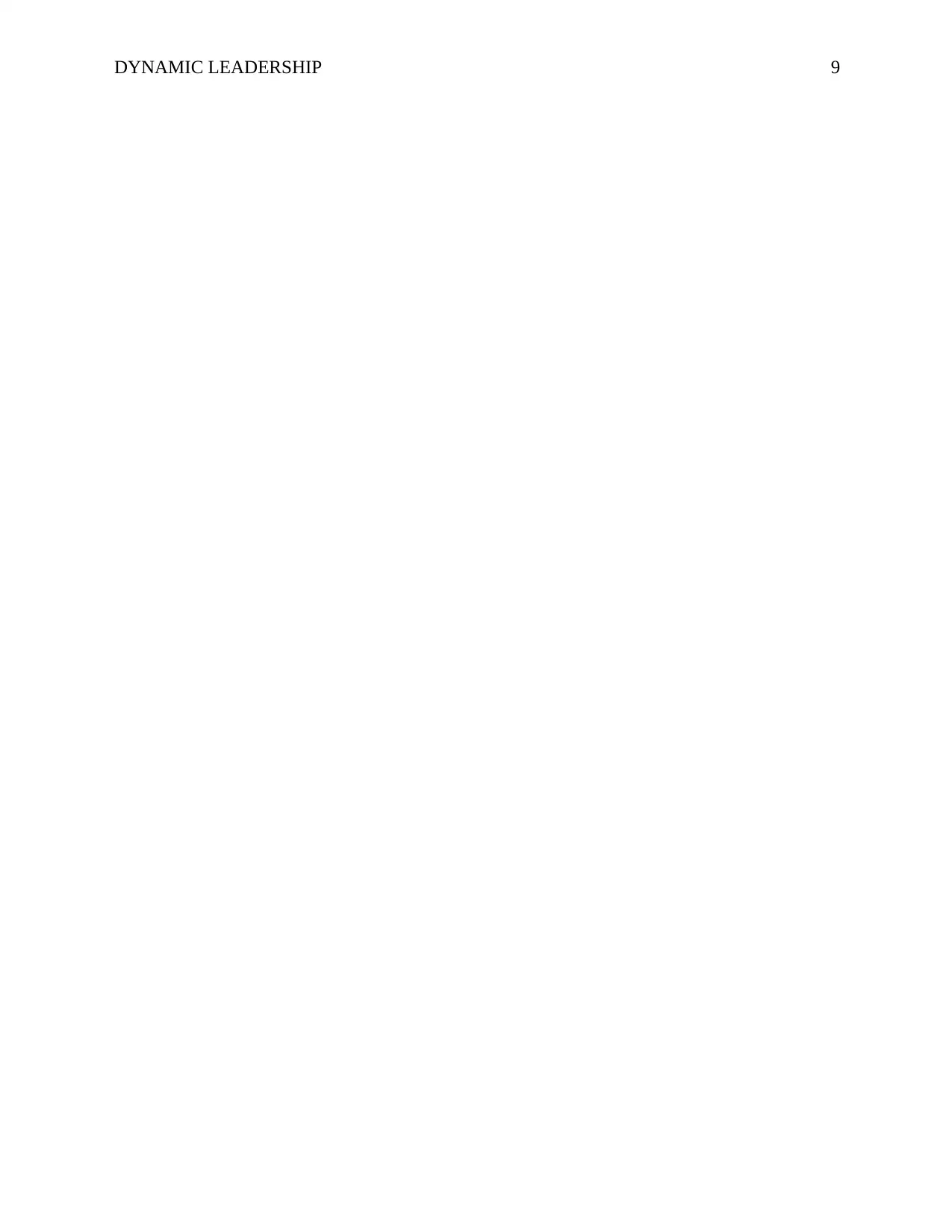
DYNAMIC LEADERSHIP 9
⊘ This is a preview!⊘
Do you want full access?
Subscribe today to unlock all pages.

Trusted by 1+ million students worldwide
1 out of 9
Related Documents
Your All-in-One AI-Powered Toolkit for Academic Success.
+13062052269
info@desklib.com
Available 24*7 on WhatsApp / Email
![[object Object]](/_next/static/media/star-bottom.7253800d.svg)
Unlock your academic potential
Copyright © 2020–2025 A2Z Services. All Rights Reserved. Developed and managed by ZUCOL.





